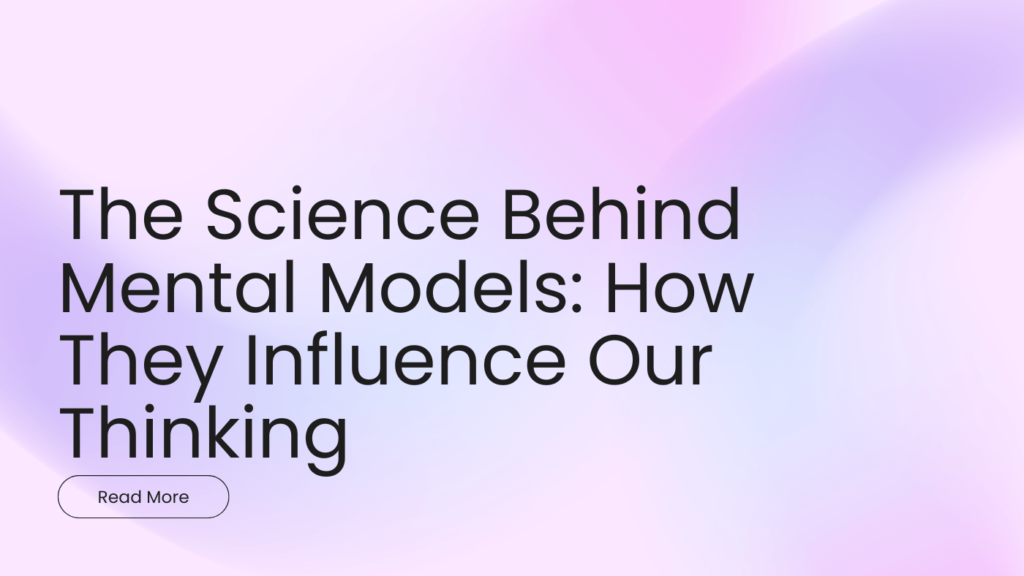The Science Behind Mental Models: How They Influence Our Thinking
Have you ever found yourself quickly grasping a complex concept or reacting instinctively to a familiar situation? Chances are, you were leveraging a mental model. Mental models are fundamental to how we navigate the world, shaping our understanding, decision-making, and problem-solving abilities. But what exactly are mental models, and how do they work? This post delves into the science of mental models, exploring their roots in psychology and cognitive science to understand their profound influence on our thinking.
What are Mental Models?
At their core, mental models are internal representations of external reality. They are simplified, subjective frameworks that help us predict outcomes, explain events, and understand the world around us. Think of them as shortcuts that allow us to make sense of complex information and act efficiently. These models aren’t perfect replicas; they’re abstractions tailored to our individual experiences and beliefs.
Kenneth Craik, a Scottish psychologist, first introduced the concept of mental models in his 1943 book, “The Nature of Explanation.” Craik proposed that the mind constructs “small-scale models” of reality that can be used to anticipate events and guide behavior.
Examples of mental models abound in everyday life:
- Driving a car: You have a mental model of how the steering wheel, accelerator, and brakes interact to control the vehicle.
- Using a computer: You understand, at least conceptually, how clicking an icon leads to a specific action.
- Interacting with people: You form mental models of others based on past interactions, influencing how you communicate and respond to them.
The Science of Mental Models
The science of mental models draws upon various disciplines, including psychology, cognitive science, and neuroscience, to understand how these internal representations are formed, stored, and utilized.
One key aspect is the role of cognitive schemas. Schemas are organized patterns of thought and behavior that categorize information and relationships among them. They act as building blocks for mental models, providing a framework for understanding new experiences. Jean Piaget’s work on cognitive development highlighted the importance of schemas in children’s understanding of the world (Piaget, J. (1954). The construction of reality in the child).
Furthermore, Bayesian inference plays a significant role in updating and refining our mental models. As we encounter new information, we adjust our beliefs and expectations based on the probability of that information being true, given our existing model. This iterative process allows us to continuously improve our understanding of the world. A classic example is the work by Clark, A. (2013). Surfing Uncertainty: Prediction, Action, and the Embodied Mind, which discusses the predictive processing framework, heavily reliant on Bayesian principles.
Neuroscience provides further insights into the neural underpinnings of mental models. Studies using fMRI and EEG have shown that specific brain regions, such as the prefrontal cortex and hippocampus, are involved in the formation and manipulation of mental models. These regions are crucial for working memory, executive function, and spatial reasoning, all of which are essential for constructing and utilizing internal representations.
Mental Models and Psychology
Mental models and psychology are deeply intertwined. Psychologists study how mental models influence our perception, memory, reasoning, and decision-making.
Cognitive biases, systematic errors in thinking, often arise from flawed or incomplete mental models. For example, the availability heuristic, where we overestimate the likelihood of events that are easily recalled, can be attributed to a mental model that overemphasizes recent or vivid experiences. Kahneman, D. (2011). Thinking, Fast and Slow provides an in-depth look at cognitive biases and their impact on decision-making.
Problem-solving is heavily reliant on mental models. When faced with a challenge, we construct a mental model of the problem, explore potential solutions within that model, and select the most promising course of action. The effectiveness of our problem-solving depends on the accuracy and completeness of our mental model.
Social cognition also relies on mental models. We develop mental models of other people, their intentions, and their likely behaviors. These models influence how we interpret their actions, predict their future behavior, and interact with them. Theory of Mind, the ability to understand that others have beliefs and desires different from our own, is a key component of social cognition and relies heavily on mental models.
Cognitive Science and Mental Models
Cognitive science and mental models explore how these representations function within the broader context of human cognition. This involves computational modeling, artificial intelligence, and the study of how information is processed and manipulated in the mind.
Computational models of mental models aim to simulate how these internal representations are constructed and used. These models can help us understand the underlying mechanisms of cognition and predict how people will behave in different situations. They often incorporate elements of logic, probability, and connectionist networks.
Artificial intelligence (AI) research draws inspiration from mental models in designing intelligent systems. By incorporating internal representations and reasoning capabilities, AI systems can mimic human-like problem-solving and decision-making. For example, knowledge representation techniques in AI often aim to capture the structure and relationships found in human mental models.
Mental Model Theory in cognitive science (Johnson-Laird, P. N. (1983). Mental Models: Towards a Cognitive Science of Language, Inference, and Consciousness) offers a specific framework for understanding how people reason and draw inferences. It posits that people reason by constructing mental models of possible scenarios and evaluating the truth of conclusions based on those models. This theory has been applied to a wide range of cognitive tasks, including deduction, induction, and counterfactual reasoning.
Improving Your Mental Models
Recognizing the power of mental models allows you to actively improve them, leading to better decision-making, problem-solving, and overall understanding. Here are some strategies:
- Seek diverse perspectives: Expose yourself to different viewpoints and experiences to challenge your existing models and broaden your understanding.
- Actively learn: Continuously acquire new knowledge and skills to update your mental models and make them more accurate.
- Reflect on your experiences: Analyze your past decisions and actions to identify biases and flaws in your mental models.
- Practice critical thinking: Question assumptions, evaluate evidence, and consider alternative explanations to refine your understanding.
- Embrace experimentation: Test your mental models by trying new things and observing the results.
Conclusion
Mental models are the invisible scaffolding that supports our thinking, shaping how we perceive, understand, and interact with the world. By understanding the science of mental models and actively working to improve them, we can unlock our cognitive potential and make better decisions in all aspects of life. Exploring the intersections between mental models and psychology, and delving into cognitive science and mental models provides a deeper understanding of these powerful internal tools.


